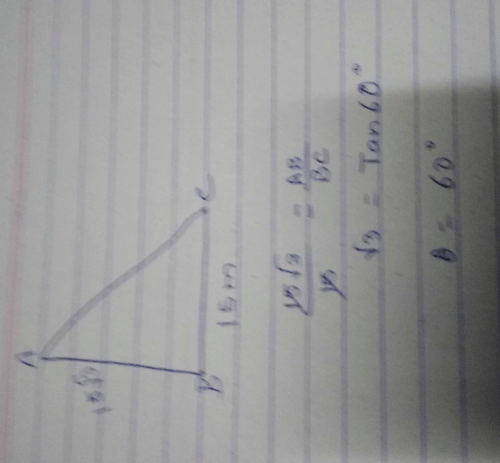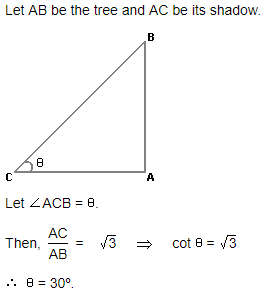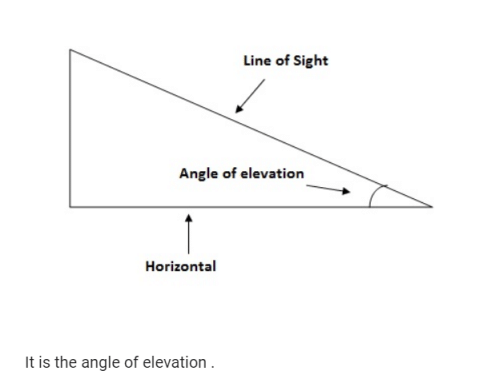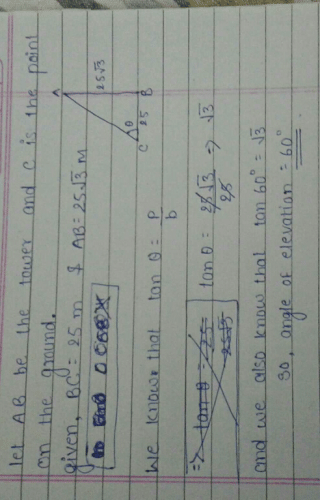All Exams >
Class 10 >
Weekly Tests for Class 10 Preparation >
All Questions
All questions of September Week 4 for Class 10 Exam
If the length of a shadow cast by a pole is √3 times the length of the pole, then the angle of elevation of the sun is- a)45°
- b)60°
- c)30°
- d)90°
Correct answer is option 'C'. Can you explain this answer?
If the length of a shadow cast by a pole is √3 times the length of the pole, then the angle of elevation of the sun is
a)
45°
b)
60°
c)
30°
d)
90°
|
|
Anjana Khatri answered |
Consider the height of tower be h
∴ height of shadow =√3h .
In a triangle ABC,
tan ∠ACB = h / √3h
tan ∠ACB = 1 / √3
∠ACB = 30degree.
Therefore, angle of elevation is 30degree .
Six Lane Highways are called- a)National Highway
- b)International Highway
- c)State Highway
- d)Golden quadrilateral super highways
Correct answer is option 'D'. Can you explain this answer?
Six Lane Highways are called
a)
National Highway
b)
International Highway
c)
State Highway
d)
Golden quadrilateral super highways
|
|
Amit Kumar answered |
Golden quadrilateral superhighways are 6 lane roads constructed to connect main Port cities of india. they are constructed to save time and reduce the distance between the main Port cities. they connect the cities like Calcutta, delhi, mumbai,and chennai.
The angle of elevation of the sun, when the length of the shadow of a tree is equal to the height of the tree, is:- a)45°
- b)60°
- c)30°
- d)None of these
Correct answer is option 'C'. Can you explain this answer?
The angle of elevation of the sun, when the length of the shadow of a tree is equal to the height of the tree, is:
a)
45°
b)
60°
c)
30°
d)
None of these
|
|
Ananya Das answered |
Consider the diagram shown above where QR represents the tree and PQ represents its shadow
We have, QR = PQ
Let ∠QPR = θ
tan θ = QR/PQ = 1 (since QR = PQ)
⇒ θ = 45°
Let ∠QPR = θ
tan θ = QR/PQ = 1 (since QR = PQ)
⇒ θ = 45°
i,e., required angle of elevation = 45°
A tower stands vertically on the ground. From a point on the ground which is 25 m away from the foot of the tower, the angle of elevation of the top of the tower is found to be 45o. Then the height (in meters) of the tower is- a)25
- b)25√3
- c)12.5
- d)25√2
Correct answer is option 'A'. Can you explain this answer?
A tower stands vertically on the ground. From a point on the ground which is 25 m away from the foot of the tower, the angle of elevation of the top of the tower is found to be 45o. Then the height (in meters) of the tower is
a)
25
b)
25√3
c)
12.5
d)
25√2
|
|
Vikram Kapoor answered |
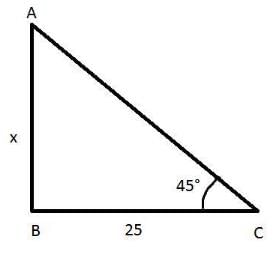
A point on the ground which is 25 m away from the foot of the tower i. BC= 25 m
Let the height of the tower be x
The angle of elevation of the tower is found to be 45 degree.i.e.∠ACB=45°
In ΔABC
Using trigonometric ratios
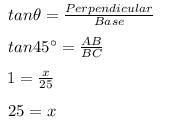
Hence the height of the tower is 25 m.

Hence the height of the tower is 25 m.
A 20 m long ladder touches the wall at a height of 10 m. The angle which the ladder makes with the horizontal is- a)450
- b)300
- c)900
- d)600
Correct answer is option 'B'. Can you explain this answer?
A 20 m long ladder touches the wall at a height of 10 m. The angle which the ladder makes with the horizontal is
a)
450
b)
300
c)
900
d)
600
|
|
Anjana Khatri answered |
ATQ , perpendicular /hypotenuse= 10/20
i.e sinθ = 10/ 20
sinθ= 1/2
so, sin 30 deg= 1/2
required angle = 30 Deg
Tree is broken by the wind the top struck the ground at 30° at a distance of 30m. away from the root. Find the height of the tree.
- a)45.9
- b)88.60
- c)54.63
- d) 51.96
Correct answer is option 'D'. Can you explain this answer?
Tree is broken by the wind the top struck the ground at 30° at a distance of 30m. away from the root. Find the height of the tree.
a)
45.9
b)
88.60
c)
54.63
d)
51.96
|
|
Neha Patel answered |
let ,
the height of standing part of the tree be = h
the height of fallen part (forms hypotenuse) be = x
then the total height of the tree will be = h + x
now,
tan 30 = h/30 m
1/√3 = h/30 m
30/√3 = h
⇒ h= 30/√3 m .... 1
similarly,
cos 30 = 30 m/ x
√3/2 = 30 / x
√3x = (30)2
√3x = 60 m
⇒ x = 60 / √3 m ....2
( we now have both value of h and x )
on adding equation1 & 2 :
⇒ h + x = 30 /√3 +60 /√3
=90 /√3 m
= 60√3 m
so , the total height of the tree is 60√3 m .
Golden quadrilateral super highways are maintained by- a)Zila Parishad
- b)PWD
- c)CPWD
- d)NHAI
Correct answer is option 'D'. Can you explain this answer?
Golden quadrilateral super highways are maintained by
a)
Zila Parishad
b)
PWD
c)
CPWD
d)
NHAI
|
|
Pooja Shah answered |
The Golden Quadrilateral project is managed by the National Highways Authority of India (NHAI) under the Ministry of Road, Transport and Highways.
Border Roads are constructed by- a)CRPF
- b)BSF
- c)Indian Army
- d)BRO
Correct answer is option 'D'. Can you explain this answer?
Border Roads are constructed by
a)
CRPF
b)
BSF
c)
Indian Army
d)
BRO
|
|
Amit Sharma answered |
The BRO operates and maintains over 32,885 kilometers of roads and about 12,200 meters of permanent bridges in the country.
A tree casts a shadow 4 m long on the ground, when the angle of elevation of the sun is 45o. The height of the tree is:- a)5.2 m
- b)4 m
- c)3 m
- d)4.5 m
Correct answer is option 'B'. Can you explain this answer?
A tree casts a shadow 4 m long on the ground, when the angle of elevation of the sun is 45o. The height of the tree is:
a)
5.2 m
b)
4 m
c)
3 m
d)
4.5 m
|
|
Nisha Choudhury answered |
In a triangle with one angle being 90 degrees (which the tree makes with the ground) and the other being 45 degrees (the angle of elevation), the 3rd angle is bound to be 45 degrees (180 - 90 - 45 = 45).
We also know that sides opposite to equal angles are equal.
Hence, the height of the tree will also be 4m.
Let AC be the rope whose length is 20 m, and AB be the vertical pole of height h m and the angle of elevation of A at point C on the ground is 30°.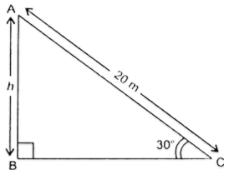
- a)10 m
- b)21 m
- c)19 m
- d)17 m
Correct answer is option 'A'. Can you explain this answer?
Let AC be the rope whose length is 20 m, and AB be the vertical pole of height h m and the angle of elevation of A at point C on the ground is 30°.
a)
10 m
b)
21 m
c)
19 m
d)
17 m
|
|
Ananya Das answered |
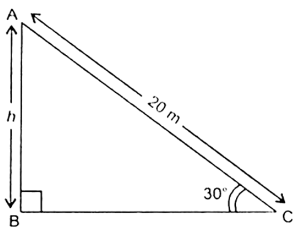
Fif. 9.11
i.e., ∠ACB = 30°
In right triangle ABC, we have
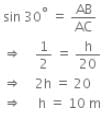
Hence, the height of the pole is 10 m.
Width of two tracks of Broad Gauge is
- a)1676 mm
- b)1.000 m
- c)0.762 m
- d)0.610 m
Correct answer is option 'A'. Can you explain this answer?
Width of two tracks of Broad Gauge is
a)
1676 mm
b)
1.000 m
c)
0.762 m
d)
0.610 m
|
|
Ananya Das answered |
Broad gauge is also called wide gauge or large line. The distance between the two tracks in these railway gauges is 1676 mm (5 ft 6 in). It would not be wrong to say that any gauge, wider than standard gauge or 1,435 mm (4 ft 8½ inches), is called broad gauge.
Provides door-to-door connectivity- a)Airways
- b)Roadways
- c)Railways
- d)Waterways
Correct answer is option 'B'. Can you explain this answer?
Provides door-to-door connectivity
a)
Airways
b)
Roadways
c)
Railways
d)
Waterways

|
Basant Mohapatra answered |
Because road are in front of your door bro not
waterway railway or airport
imagine a your runway infront of your house door
the plane will land inside your house ..
waterway railway or airport
imagine a your runway infront of your house door
the plane will land inside your house ..
A tower stands vertically on the ground. From a point C on the ground, which is 20 m away from the foot of the tower, the angle of elevation of the top of the tower is found to be 45 degrees. The height of the tower is
- a)15 m
- b)8 m
- c)20 m
- d)10 m
Correct answer is option 'C'. Can you explain this answer?
A tower stands vertically on the ground. From a point C on the ground, which is 20 m away from the foot of the tower, the angle of elevation of the top of the tower is found to be 45
degrees
. The height of the tower isa)
15 m
b)
8 m
c)
20 m
d)
10 m
|
|
Rohan Kapoor answered |
Angle of elevation =45 degrees
Base=20 m
Height of the tower=perpendicular
We have tan 45=P/B
1=P/20
P=20 m
Hence the height of the tower is 20 metres.
Base=20 m
Height of the tower=perpendicular
We have tan 45=P/B
1=P/20
P=20 m
Hence the height of the tower is 20 metres.
Natural harbour in India- a)Hooghly
- b)Paradip
- c)Chennai
- d)Mumbai
Correct answer is option 'D'. Can you explain this answer?
Natural harbour in India
a)
Hooghly
b)
Paradip
c)
Chennai
d)
Mumbai
|
|
Kavya Deshpande answered |
Mumbai is a natural harbour on the west coast and is also the biggest port of India. The port is situated closer to the general routes from the countries of middle east, Mediterranean countries. North Africa, South Africa, North America and Europe where the major share of country’s overseas trade is carried out. The port is 20km long and 6-10km wide with 54berths and has the country’s largest oil terminal.
The angle of elevation from a point 30 feet from the base of a pole, of height h, as level ground to the top of the pole is 45o. Which equation can be used to find the height of the pole.- a)cos 45° = h/30
- b)tan 45° = 30/h
- c)tan 45° = h/30
- d)sin 45° = h/30
Correct answer is option 'C'. Can you explain this answer?
The angle of elevation from a point 30 feet from the base of a pole, of height h, as level ground to the top of the pole is 45o. Which equation can be used to find the height of the pole.
a)
cos 45° = h/30
b)
tan 45° = 30/h
c)
tan 45° = h/30
d)
sin 45° = h/30
|
|
Prabhat jha answered |
= h/30
b)sin 45 = h/30
c)tan 45 = h/30
d)sec 45 = h/30
Answer: b) sin 45 = h/30
Explanation:
The angle of elevation is the angle between the horizontal ground and the line of sight to the top of the pole. In this case, the angle of elevation is 45 degrees.
We can use the trigonometric ratio of sine to find the height of the pole. The sine of an angle is the ratio of the opposite side to the hypotenuse in a right triangle.
In this case, the opposite side is the height of the pole (h) and the hypotenuse is the distance from the point to the base of the pole (30 feet). Therefore, we have:
sin 45 = h/30
Solving for h, we get:
h = 30 sin 45
Using a calculator, we find that sin 45 is approximately 0.707. Therefore,
h = 30 x 0.707 = 21.21 feet
So the height of the pole is approximately 21.21 feet.
b)sin 45 = h/30
c)tan 45 = h/30
d)sec 45 = h/30
Answer: b) sin 45 = h/30
Explanation:
The angle of elevation is the angle between the horizontal ground and the line of sight to the top of the pole. In this case, the angle of elevation is 45 degrees.
We can use the trigonometric ratio of sine to find the height of the pole. The sine of an angle is the ratio of the opposite side to the hypotenuse in a right triangle.
In this case, the opposite side is the height of the pole (h) and the hypotenuse is the distance from the point to the base of the pole (30 feet). Therefore, we have:
sin 45 = h/30
Solving for h, we get:
h = 30 sin 45
Using a calculator, we find that sin 45 is approximately 0.707. Therefore,
h = 30 x 0.707 = 21.21 feet
So the height of the pole is approximately 21.21 feet.
Bulk carrier across nations- a)Airways
- b)Roadways
- c)Railways
- d)Waterways
Correct answer is option 'D'. Can you explain this answer?
Bulk carrier across nations
a)
Airways
b)
Roadways
c)
Railways
d)
Waterways
|
|
Suyash Goyal answered |
Bulk carrier across nations is
Waterways
Find AB in the given figure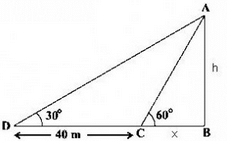
- a)√3
- b)30√3
- c)20√3
- d)10√3
Correct answer is option 'C'. Can you explain this answer?
Find AB in the given figure
a)
√3
b)
30√3
c)
20√3
d)
10√3
|
|
Chiranjeev Manjunathan answered |
Given:
DC=40cm
CB=Xcm
AB=(40+X)cm
To find:
AB=h=?
Sol:
tan60= opp/adj = h/X=√3 => h=X√3 —>1
tan30= opp/adj = h/40+X=1/√3 => h=(40+X)/√3 —>2
from eq.1&2:
X√3 = (40+X)/√3
3X=40+X
2X=40
X=20
therefore, h=(40+20)/√3
h=20√3
hence the option is 'c'
DC=40cm
CB=Xcm
AB=(40+X)cm
To find:
AB=h=?
Sol:
tan60= opp/adj = h/X=√3 => h=X√3 —>1
tan30= opp/adj = h/40+X=1/√3 => h=(40+X)/√3 —>2
from eq.1&2:
X√3 = (40+X)/√3
3X=40+X
2X=40
X=20
therefore, h=(40+20)/√3
h=20√3
hence the option is 'c'
What is the purpose of using contraceptive devices?Options:- a)To improve fertility
- b)To prevent pregnancy
- c)To increase the release of eggs
- d)To change body growth hormones
Correct answer is option 'B'. Can you explain this answer?
What is the purpose of using contraceptive devices?Options:
a)
To improve fertility
b)
To prevent pregnancy
c)
To increase the release of eggs
d)
To change body growth hormones

|
Nk Classes answered |
The purpose of using contraceptive devices is to prevent pregnancy.
Contraceptive methods are designed to help individuals manage their reproductive health. Here are some key points:
- Contraceptives create a barrier to stop sperm from reaching the egg.
- Some contraceptives may have side effects due to hormonal changes.
Using contraceptive devices is essential for individuals who wish to avoid unintended pregnancies and manage their reproductive choices effectively.
Bulk carrier within India
- a)Airways
- b)Roadways
- c)Waterways
- d)None of these
Correct answer is option 'C'. Can you explain this answer?
Bulk carrier within India
a)
Airways
b)
Roadways
c)
Waterways
d)
None of these
|
|
Tanvi sharma answered |
Explanation:
A bulk carrier is a type of ship that is specifically designed to transport bulk cargo such as coal, iron ore, and grain. It is characterized by its large size and open cargo holds, which allow for the efficient loading and unloading of bulk cargo.
Railways as a mode of transportation for bulk carriers in India
One of the modes of transportation for bulk carriers within India is railways. Railways play a crucial role in the transportation of goods across the country, including bulk cargo. Here's why railways are a suitable mode of transportation for bulk carriers:
1. Efficient and cost-effective:
Railways provide a cost-effective and efficient means of transporting bulk cargo over long distances. They have the capacity to carry large quantities of cargo in a single trip, reducing the number of journeys required to transport the goods.
2. Extensive railway network:
India has an extensive railway network that spans across the entire country. This network connects major industrial areas, ports, and mines, making it convenient for bulk carriers to transport goods from one location to another.
3. Dedicated freight corridors:
India is in the process of developing dedicated freight corridors, which are specifically designed for the smooth movement of freight trains. These corridors will further enhance the efficiency and capacity of railways for transporting bulk cargo.
4. Specialized infrastructure:
Railways have specialized infrastructure such as goods yards, sidings, and loading/unloading facilities that are specifically designed for handling bulk cargo. This infrastructure ensures smooth and efficient operations during the loading and unloading of goods.
5. Reduced environmental impact:
Compared to other modes of transportation such as roadways, railways have a lower carbon footprint. They consume less fuel per ton-kilometer of cargo transported, resulting in reduced greenhouse gas emissions and environmental impact.
6. Government initiatives:
The Indian government has undertaken various initiatives to promote the use of railways for transporting bulk cargo. These include the development of multi-modal logistics parks and the introduction of policies to encourage private sector participation in the rail freight sector.
Overall, railways are a suitable mode of transportation for bulk carriers within India due to their efficiency, extensive network, specialized infrastructure, and reduced environmental impact. They play a vital role in the transportation of bulk cargo, supporting various industries and contributing to the country's economic growth.
Principal mode of transportation for freight and passengers in India- a)Airways
- b)Roadways
- c)Railways
- d)Waterways
Correct answer is option 'C'. Can you explain this answer?
Principal mode of transportation for freight and passengers in India
a)
Airways
b)
Roadways
c)
Railways
d)
Waterways

|
Sushil Solanki answered |
Principal mode of transportation for freight and passengers in India are:
1. Railways: Railways are the most important mode of transportation in India, both for freight and passengers. It is the backbone of the country's transportation system and plays a vital role in connecting different regions and facilitating the movement of goods and people. Key points about railways in India include:
- Indian Railways is one of the largest railway networks in the world, covering a vast distance and connecting thousands of towns and cities.
- It provides various types of trains, including passenger trains, express trains, and freight trains, catering to the different needs of people and industries.
- Railways offer a cost-effective and efficient means of transportation for both goods and passengers, with well-established routes and schedules.
- Freight trains carry a wide range of commodities, including raw materials, agricultural products, industrial goods, and petroleum products, among others.
- Passenger trains provide affordable and convenient travel options for people across different income groups, with various classes and facilities available.
2. Roadways: While railways dominate long-distance transportation, roadways play a crucial role in last-mile connectivity and transportation within cities and towns. Key points about roadways in India include:
- India has an extensive road network, with national highways, state highways, and local roads connecting various parts of the country.
- Roadways are essential for transporting goods and passengers to remote areas where railways may not be accessible.
- Trucks, buses, and other vehicles are widely used to transport goods and people, offering flexibility and convenience.
- Road transport is essential for the distribution of goods from railway stations to final destinations and for door-to-door delivery services.
- However, road transport is often affected by traffic congestion, road conditions, and other challenges, impacting efficiency and travel time.
3. Waterways: India has a vast network of rivers, canals, and coastal areas, making waterways another significant mode of transportation. Key points about waterways in India include:
- Inland waterways, such as rivers and canals, are used for transporting goods and passengers, especially in regions with extensive water resources.
- Coastal shipping is an important mode for transporting goods along the country's coastline, connecting major ports and facilitating trade.
- Water transport is particularly suitable for carrying heavy and bulky goods, such as minerals, coal, and construction materials.
- The government has been working on developing and modernizing waterways to enhance connectivity and promote environmentally friendly transportation options.
4. Airways: While air transport is widely used for passenger travel, it plays a relatively smaller role in freight transportation in India. Key points about airways in India include:
- Air transport is the fastest mode of transportation, suitable for long-distance travel and urgent delivery of goods.
- It is primarily used for carrying high-value and time-sensitive goods, such as perishable goods, pharmaceuticals, and electronic equipment.
- Airports are strategically located across the country, connecting major cities and international destinations.
- However, air transport is relatively expensive compared to other modes, making it less accessible for bulk transportation of goods.
Overall, railways are the principal mode of transportation for both freight and passengers in India, followed by roadways, waterways, and airways. These modes work together to ensure efficient connectivity and movement of goods and people across the country.
1. Railways: Railways are the most important mode of transportation in India, both for freight and passengers. It is the backbone of the country's transportation system and plays a vital role in connecting different regions and facilitating the movement of goods and people. Key points about railways in India include:
- Indian Railways is one of the largest railway networks in the world, covering a vast distance and connecting thousands of towns and cities.
- It provides various types of trains, including passenger trains, express trains, and freight trains, catering to the different needs of people and industries.
- Railways offer a cost-effective and efficient means of transportation for both goods and passengers, with well-established routes and schedules.
- Freight trains carry a wide range of commodities, including raw materials, agricultural products, industrial goods, and petroleum products, among others.
- Passenger trains provide affordable and convenient travel options for people across different income groups, with various classes and facilities available.
2. Roadways: While railways dominate long-distance transportation, roadways play a crucial role in last-mile connectivity and transportation within cities and towns. Key points about roadways in India include:
- India has an extensive road network, with national highways, state highways, and local roads connecting various parts of the country.
- Roadways are essential for transporting goods and passengers to remote areas where railways may not be accessible.
- Trucks, buses, and other vehicles are widely used to transport goods and people, offering flexibility and convenience.
- Road transport is essential for the distribution of goods from railway stations to final destinations and for door-to-door delivery services.
- However, road transport is often affected by traffic congestion, road conditions, and other challenges, impacting efficiency and travel time.
3. Waterways: India has a vast network of rivers, canals, and coastal areas, making waterways another significant mode of transportation. Key points about waterways in India include:
- Inland waterways, such as rivers and canals, are used for transporting goods and passengers, especially in regions with extensive water resources.
- Coastal shipping is an important mode for transporting goods along the country's coastline, connecting major ports and facilitating trade.
- Water transport is particularly suitable for carrying heavy and bulky goods, such as minerals, coal, and construction materials.
- The government has been working on developing and modernizing waterways to enhance connectivity and promote environmentally friendly transportation options.
4. Airways: While air transport is widely used for passenger travel, it plays a relatively smaller role in freight transportation in India. Key points about airways in India include:
- Air transport is the fastest mode of transportation, suitable for long-distance travel and urgent delivery of goods.
- It is primarily used for carrying high-value and time-sensitive goods, such as perishable goods, pharmaceuticals, and electronic equipment.
- Airports are strategically located across the country, connecting major cities and international destinations.
- However, air transport is relatively expensive compared to other modes, making it less accessible for bulk transportation of goods.
Overall, railways are the principal mode of transportation for both freight and passengers in India, followed by roadways, waterways, and airways. These modes work together to ensure efficient connectivity and movement of goods and people across the country.
What is the surgical method used in males for contraception, as described in the content?- a)Blocking the fallopian tube
- b)Blocking the vas deferens
- c)Placing an IUCD
- d)Using chemical methods
Correct answer is option 'B'. Can you explain this answer??
a)
Blocking the fallopian tube
b)
Blocking the vas deferens
c)
Placing an IUCD
d)
Using chemical methods

|
Atharva Menon answered |
Understanding Male Contraception
Contraceptive methods aim to prevent pregnancy, and in males, the most commonly discussed surgical method is a vasectomy.
What is a Vasectomy?
- A vasectomy is a surgical procedure that involves cutting and sealing the vas deferens, the tubes that carry sperm from the testicles to the urethra.
- This procedure effectively blocks sperm from mixing with semen, thus preventing sperm from being released during ejaculation.
Procedure Details
- The surgery is typically performed under local anesthesia.
- It can be done through small incisions or using a no-scalpel technique, which minimizes bleeding and recovery time.
- The procedure usually lasts about 15-30 minutes, and patients can often return home the same day.
Effectiveness of Vasectomy
- A vasectomy is one of the most effective forms of contraception, with a success rate exceeding 99%.
- It is considered a permanent method of contraception, although reversibility is possible in some cases.
Benefits of Vasectomy
- No impact on hormone levels or sexual function.
- It is a safer option compared to female sterilization.
- It eliminates the need for other contraceptive methods, providing long-term peace of mind.
Conclusion
In summary, the correct answer to the question regarding male surgical contraception is option 'B': blocking the vas deferens through a vasectomy. This method is a reliable and effective way for males to take control of their reproductive health.
Contraceptive methods aim to prevent pregnancy, and in males, the most commonly discussed surgical method is a vasectomy.
What is a Vasectomy?
- A vasectomy is a surgical procedure that involves cutting and sealing the vas deferens, the tubes that carry sperm from the testicles to the urethra.
- This procedure effectively blocks sperm from mixing with semen, thus preventing sperm from being released during ejaculation.
Procedure Details
- The surgery is typically performed under local anesthesia.
- It can be done through small incisions or using a no-scalpel technique, which minimizes bleeding and recovery time.
- The procedure usually lasts about 15-30 minutes, and patients can often return home the same day.
Effectiveness of Vasectomy
- A vasectomy is one of the most effective forms of contraception, with a success rate exceeding 99%.
- It is considered a permanent method of contraception, although reversibility is possible in some cases.
Benefits of Vasectomy
- No impact on hormone levels or sexual function.
- It is a safer option compared to female sterilization.
- It eliminates the need for other contraceptive methods, providing long-term peace of mind.
Conclusion
In summary, the correct answer to the question regarding male surgical contraception is option 'B': blocking the vas deferens through a vasectomy. This method is a reliable and effective way for males to take control of their reproductive health.
Chapter doubts & questions for September Week 4 - Weekly Tests for Class 10 Preparation 2025 is part of Class 10 exam preparation. The chapters have been prepared according to the Class 10 exam syllabus. The Chapter doubts & questions, notes, tests & MCQs are made for Class 10 2025 Exam. Find important definitions, questions, notes, meanings, examples, exercises, MCQs and online tests here.
Chapter doubts & questions of September Week 4 - Weekly Tests for Class 10 Preparation in English & Hindi are available as part of Class 10 exam.
Download more important topics, notes, lectures and mock test series for Class 10 Exam by signing up for free.

Contact Support
Our team is online on weekdays between 10 AM - 7 PM
Typical reply within 3 hours
|
Free Exam Preparation
at your Fingertips!
Access Free Study Material - Test Series, Structured Courses, Free Videos & Study Notes and Prepare for Your Exam With Ease

 Join the 10M+ students on EduRev
Join the 10M+ students on EduRev
|

|
Create your account for free
OR
Forgot Password
OR
Signup to see your scores
go up within 7 days!
Access 1000+ FREE Docs, Videos and Tests
Takes less than 10 seconds to signup


